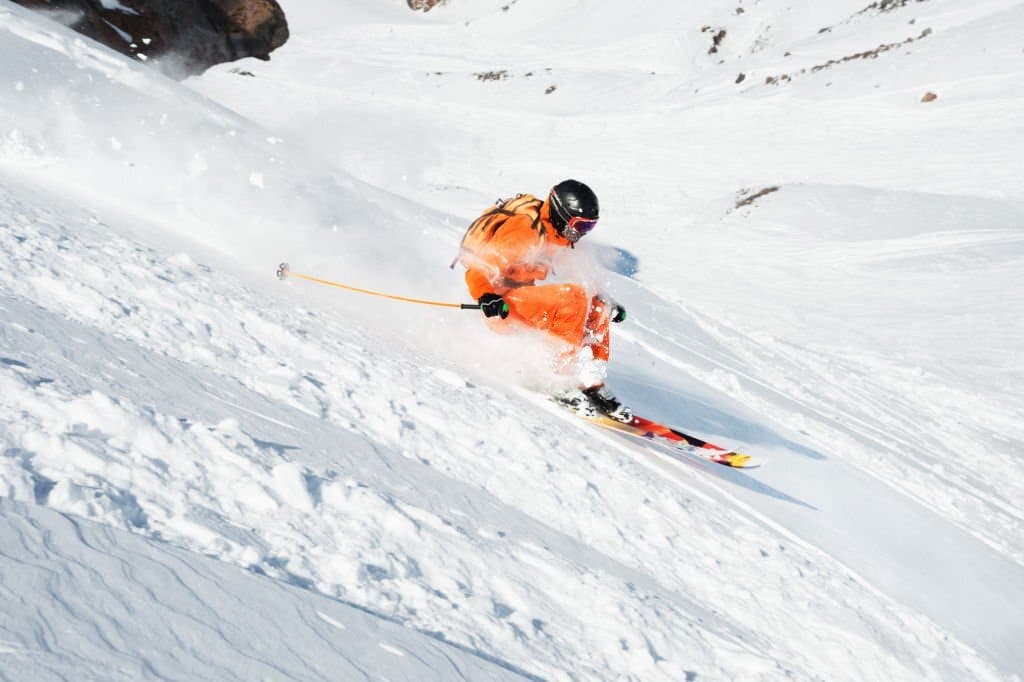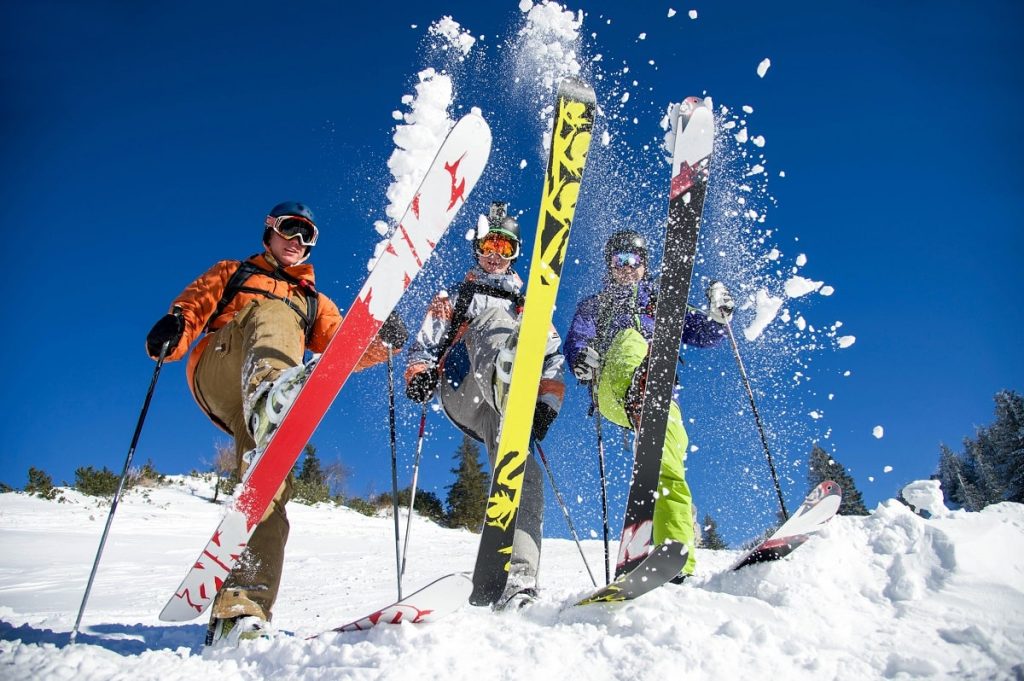Mid-grade Vs. Top Of The Line Skis, Is There a Noticeable Difference? (Wood, Kevlar & Fiberglass)
Every year skiing equipment seems to get more and more expensive. The range of ski prices varies widely, which makes customers wonder if top-of-the-line skis are worth the extra cost compared to their mid-grade counterparts.
The best skis on the market perform much better than middle-of-the-road skis, as long as the skier is experienced enough to know how to handle them. They are made of much more durable and flexible materials than cheaper skis, meaning that you will be able to find a pair that match your particular riding style.

We are reader supported. We may collect a share of sales from the links on this page. As an Amazon Associate, we earn from qualifying purchases.
Differences Between Mid-grade And More Expensive Skis

Often the price tag on a pair of skis is increased as a result of the brand or artwork featured on the top sheets. However, most good skis are constructed with improved methods and superior materials. They will undoubtedly last longer than a cheaper ski and will be designed for a specific skiing style or snow condition.
The Difference in Core Materials Begin Used
Cheaper skis have cores usually made from inexpensive materials, so they won’t be able to take the beating that a superior pair can. The core of a ski provides stability, serving as the backbone and where will dictate the performance of the whole ski.
Over the years, ski cores have developed with technology, along with the materials used to make them. Common materials used to construct ski cores include:
- Carbon fiber
- Kevlar
- Foam
- Wood
- Metal alloys
- Fiberglass
Every core has pros and cons, so there is generally a payoff between producing a durable and light ski, which is still as stiff or flexible as the skier needs it to be.
Cheaper Core Materials
- The foam is light but weak. It can aid in ski flexibility, but it isn’t very durable.
- Kevlar is solid and semi-light. It is not quite as rigid as aluminum or titanium and weighs considerably more than carbon fiber.
- Fiberglass is strong and light, but also inexpensive.
- Softwoods, like balsa, poplar, and aspen, are light and flexible, but they lack rigidity, which isn’t suitable for an expert rider who is used to skiing fast and hard.
Light and flexible skis are easy to maneuver when making turns and very forgiving for skiers who haven’t mastered carving at high speeds. Unfortunately, they lack the stiffness and dampening to absorb the extra forces expert skiers exert.
More Expensive Core Materials
- Hardwoods, like ash or maple. These cores enable a ski able to hold an edge at high speeds and in icy conditions, but they are stiffer and harder to turn, especially at lower speeds.
- Titanium is extremely strong yet light and provides better dampening than most metals.
- Titanal is an aluminum alloy consisting of titanium, vanadium, and other alloys. It is solid and dampens much better than fiberglass, carbon fiber, and Kevlar.
- Aluminum Honeycomb is much lighter than titanium, but it isn’t as strong and doesn’t dampen as well.
- Carbon Fiber is one of the lightest, most robust, and most flexible core materials on the market. Its strength is comparable to most hardwoods, but it is costly.
More expensive skis can be light and flexible, like their cheaper counterparts. However, you should consider your skiing style before choosing a core that will cost you considerably more. Inexperienced skiers don't need a core’s stiffness or dampening abilities because their style of skiing exerts much lower force.
Check Price on Backcountry.com
Sidewall Construction
There are three different types of sidewalls that skis can come equipped with.
Key takeaway: Inexpensive skis will generally be built with an ABS sidewall or a capped sidewall, while more expensive skis usually have a hybrid of both.

ABS Sidewalls
Also known as a sandwich construction, this type of sidewall is inserted on either side of the ski’s core to shield it. This design is effective for high-speed situations, like racing, where stiffness, edge hold, and impact resistance are paramount.
The downside of this style of sidewall is that it is heavy and makes the ski prone to damage, especially collision damage from another ski. Skiing at high speeds can cause the inside of your skis to come into contact with each other, damaging the sidewall and top sheet.
Capped Sidewalls
Cap sidewalls are constructed with the top sheet folding over the core, creating a seal from moisture. This construction method is lighter than ABS and doesn’t leave your top sheet exposed to damage, however, it isn’t as stiff, making holding an edge at high speed unreliable.
Hybrid & Half Cap Sidewalls
Hybrid sidewalls are most commonly found on better skis because they effectively balance the pros and cons of the other two sidewall types. Hybrid construction allows maximum stiffness, durability, and edge hold while also remaining relatively light.
This type of sidewall generally contains a smaller ABS sidewall towards the middle of the ski and slowly transforms into a capped sidewall at the tail and tip.
Topsheet Construction
There are two different processes by which top sheets can be applied to a ski, encapsulation, and sublimation. Encapsulation provides an attractive-looking sheen on top of the ski’s graphics, while sublimation allows the graphic to be a part of the top sheet.

Encapsulation
This method involves a transparent top sheet being placed over a ski's graphics. This is a popular production method because it looks good, but on the downside, they are more susceptible to delamination, which can destroy a ski if water gets into its core.
Sublimation
With sublimation, the graphics are transposed into the top sheet itself. Sublimation is ideal because it doesn’t require a clear top sheet to be placed over the graphic, which can easily delaminate.
Sublimation is becoming more common on better skis, as delamination is hard to reverse and can destroy a ski in no time at all.
Base Construction
All ski bases are made of P-Tex, but there are a variety of manufacturing processes that will determine how durable and fast the ski will be.

Extruded Bases
Extruded bases are manufactured from polyethylene, which is heated and then shaped into the form of the ski’s base. This production method is used on most cheaper skis because they aren’t as durable and much slower than sintered bases.
Sintered Bases
Sintered bases are created by grinding polyethylene into a powder, then heating it, and pressing it into a slab, which is finally cut to the correct shape. This process is more time-consuming and expensive, but the finished result is more durable and much better at absorbing wax.
Edges
There are two primary methods for constructing ski edges.
Key takeaway: One involves wrapping the edge around the entire perimeter of the ski, while the other consists of applying the edges only along the sidecuts.
Partially Wrapped Edges

Partially wrapped edges occur along the sidecuts of the ski, while the tail and tip will be edgeless. This cheaper method of building edges makes the ski lighter, but it doesn’t provide as much strength to the ski as a fully wrapped edge.
Fully Wrapped Edges
These edges are much more common on top-tier skis because of their strength. Steel or stainless steel is wrapped all the way around the ski’s perimeter, rejoining itself at the tip or tail.
Should I Upgrade To Nicer Skis?

It's a common misconception that buying nicer skis will instantly make you a better skier, but unfortunately, the opposite is usually true. Better skis possess characteristics that are counterintuitive to the learning process and can actually make skiing more challenging for a beginner.
Key Takeaway: Good skis don’t make a good skier. It all comes down to skill and technique.
Most mid-grade skis are designed to be versatile, working well during any conditions, but conversely, they don’t excel in any particular area. The best skis on the market are usually intended for specific riding styles that beginner and intermediate skiers aren’t used to.
Before you consider spending the money on some top-tier skis, you should first feel comfortable riding on many different types of terrain, no matter what the snow conditions. Upgrading your skis will usually only add to your skiing abilities if you are an intermediate to advanced skier.
Final Thoughts
Top-tier skis are often worth the heftier price tag that comes with them. For the most part, they are made of superior materials that will last longer and perform better than cheaper skis.
However, with continuing improvements in technology and materials science, the process of ski manufacturing is improving all the time so that even midrange and some budget skis will last a long time.






